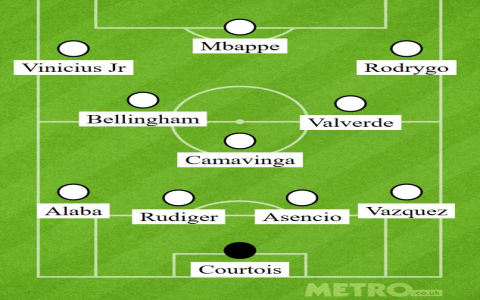Last weekend, I watched a Real Madrid match, and the more I watched, the more confused I became. The commentators kept mentioning terms like “4-3-3” and “high-pressing,” but I had no idea how the players were actually coordinating on the field. Why were the full-backs constantly pushing forward? Why did the forwards suddenly drop back? No one explained it clearly. So I decided to figure it out for myself, starting from scratch like a new fan.
I found three recent game videos, turned off the sound, and watched them on my own. I paused every five minutes and used a pen to draw the players’ positions on paper. I noted who was on the left, who was in the middle, and who was near the goal.

I also used different colored pens to mark each player’s position changes on a printed field diagram. My cat stood next to me the whole time, staring at me as if wondering if I had lost my mind.
The name of this formation sounds very professional, but it’s actually very simple: four defenders, three midfielders, and three forwards. But what’s really impressive is not the positioning, but the constant movement of the players.
At first, I thought the players stood in fixed positions, but I realized that they were constantly changing positions. The formation looks like 4-3-3, but it’s completely different when you actually play it.
Real Madrid’s fullbacks, such as Carvajal, often rush forward. He doesn’t just go up occasionally, but participates in almost every attack. Sometimes he is even further forward than the forwards.
But what if he rushes forward and can’t get back? In that case, the midfielders immediately fill in on the wing to defend. This is not a temporary reaction, but a prearranged coordination.
Real Madrid’s midfielders don’t just stand around. The three have clear roles:
Kroos is responsible for organizing the back line and passing the ball to the right place.
Modric covers a lot of ground and goes wherever he’s needed.
Valverde often pushes forward to participate in the attack.
They work as a team, not as three individuals fighting their own battles.
Many people think that forwards are only responsible for scoring goals, but at Real Madrid, wingers like Vinicius often drop back to defend. In the 80th minute of the game, I saw him rush back to his own penalty area to tackle a player, which startled me. I thought I had seen it wrong, but when I replayed the scene, I realized it was real.
This is not a coincidence, but a requirement from the coach. Wingers must quickly return to their positions after attacking, otherwise the wing will be left open.
Although Benzema is a center forward, he doesn’t always stay up front. He often drops back to midfield to get the ball, acting a bit like a temporary midfielder.
When he drops back, the wingers have space to cut inside. The opposing defenders don’t know whether to follow him or stay back, which creates chaos. Not everyone can do this kind of movement.
After watching the video, I opened FIFA and tried to replicate Real Madrid’s style of play. I set the formation to 4-3-3, had the fullbacks push forward, and had the forwards drop back.
The result was a complete disaster. The computer opponents broke through my defense time and time again, and I ended up losing 0-5. I finally realized that having the right formation isn’t enough; the key is to work together.
Later, I played five-a-side soccer with my friends and decided to try Real Madrid’s style of play. I assigned roles to them:
One person was “Kroos” and was not allowed to cross the halfway line.
‘Vinicius’ had to defend immediately after each attack.
“Benzema” had to constantly move to the wings to draw defenders away.
For the first few minutes, we played chaotically and couldn’t coordinate. But as we found our rhythm, everything suddenly clicked. In the end, we won 7-2, with several counterattacks executed flawlessly.
My biggest discovery was that Real Madrid’s formation is constantly changing. When attacking, the fullbacks move forward, making it look like a 3-2-5. When defending, the midfielders and wingers drop back, turning it into a 5-3-2.
They don’t stick to one position, but adjust according to the position of the ball. That’s what makes them so good.
At Real Madrid, no one is responsible for only their own area. When one player moves forward, another player covers for him. For example, when a full-back pushes forward, a midfielder moves to the wing. When a forward drops back, a midfielder moves forward.
This kind of coordination requires long-term training and cannot be improvised. Every player knows what his teammates will do.
Many fans watch games and only pay attention to who scores and who commits fouls. But what’s really important is the positioning and coordination between players. These details are not explained in detail in the commentary, so you can only discover them by watching more games yourself.
I used to just watch the excitement, but now I pay attention to the players’ movements and have discovered how clever the game is.
If you also want to understand how Real Madrid plays, you can do the following:
- First, learn the basic positions of a 4-3-3 formation.
- When watching a game, focus on one player and see how much ground they cover in five minutes.
- Pay attention to when the full-backs move forward and who covers their positions.
- Watch whether the forwards are defending and when they return.
- Watch several games, and you’ll gradually start to see the patterns.
Now when I watch Real Madrid matches, it feels completely different from before. I no longer just care about goals; I enjoy the process of their teamwork.
It’s like discovering a hidden trick in a game and suddenly becoming really good at it. Understanding their style of play makes the matches much more interesting.

